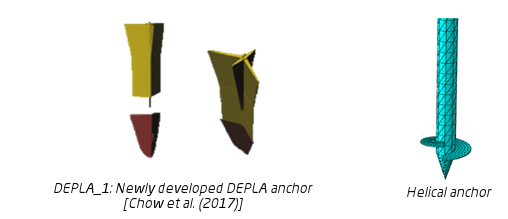
Background
Floating offshore structures (wind turbines, wave power systems, tidal turbines, …) moored to the seabed are usually employed for water depths that are beyond the range of water depths suitable for fixed offshore structures founded on the seabed . These floating structures are maintained on station using mooring lines that terminate at anchors embedded in the seabed.
A variety of anchors types exists with different capabilities and limitations in regard to the type of mooring systems and the seabed soil conditions. Traditional anchoring systems (e.g. piles) typically involve costly installation. Although the Drag Embedded Anchors DEAs are widely used nowadays for most FOWTs, they have the shortcoming of uncertain penetration depth (and thus an uncertain bearing capacity).
The ANCRE_EMR project aims at studying the performance of two types of offshore anchors used as a part of the mooring system of floating structures for possible use in practice: (i) Dynamically embedded plate anchors DEPLA and (ii) helical anchors.
Scientific advances and innovation
As far as the new model DEPLA_1 is concerned, the state-of-the-art does not present any element on the numerical modelling of this type of anchors. Experimental centrifuge studies have been conducted to check the capability of the proposed system to reach significant depths in the ground and to study the pull-out capacity of this system [Chow et al. (2017) and Chow et al. (2018)]. The originality of the ANCRE_EMR project is to carry out numerical modelling in large deformations of the installation process of the anchor and to study the influence of the different parameters influencing the final anchor penetration depth.
Concerning the helical anchor, numerical studies carried out on helical anchors generally assume that these anchors consist of an assembly of circular plates (not helices) attached to the central rod, which could lead to an inaccurate estimate of the capacity of the anchor. In addition, these studies do not consider the installation process of the anchor. The purpose of this project is to conduct three-dimensional finite element analyses of helical anchors taking into account the exact shape of the helixes and the process of anchor installation.
Expected technical and economic impact
- The computational tools developed within this project allow a more reliable and economical design, thus reducing the conservatism of the classical approaches used in practice.
- The software developed will be used by the companies involved in the sector of marine energy.
Key project milestones
- January 2020 - Beginning of the project
- June 2020 - Development of a wished-in-place helical anchor model for the computation of its pullout capacity.
- December 2020 - Numerical modeling of the installation process of the helical anchor and computation of its pullout capacity taking into account the effect of the installation.
- June 2021 - (i) Numerical modeling of the installation process of the DEPLA_1 anchor in order to determine its penetration potential into the soil, (ii) Final report writing and publications - End of project.
Demonstrator
In the ANCRE_EMR project, numerical simulations of both types of mooring (i.e. the new DEPLA_1 mooring system consisting of a dynamically embedded plate anchor and the helical anchor) will be carried out using the finite element method.
Results
The CEL (Coupled Eulerian-Lagrangian) analysis was shown to be relevant for the computation of the pullout capacity of the helical anchor (under the ‘wished-in-place’ assumption) and for the simulations related to its installation process:
a. For the calculation of the pullout bearing capacity of the helical anchor with the ‘wished-in-place’ assumption, the CEL analysis was able to rigorously determine the ultimate capacity of this anchor contrary to the classical finite element FE method; the calculation via the CEL approach having been carried out till the end without encountering any problem of convergence. Indeed, the analysis by the CEL approach makes it possible to overcome the problem of distortion of the mesh (inducing a stop of calculation) which one observes for problems with large deformations as is the case of the helical anchor problem.
b. For the helical anchor installation simulations, the classical FE analysis is unfeasible; however, the simulation of the installation process using CEL analysis was successfully performed.
The results related to the calculation of the pullout bearing capacity of the helical anchor installed in sand (using the ‘wished-in-place’ assumption and the CEL approach) are as follows:
a. For a vertical loading, the obtained pullout bearing capacity was found to be close to that of the analytical solution. For an inclined loading, a slight decrease in the pullout bearing capacity was observed for the loading inclinations that are smaller than 60° from the vertical. For an inclination greater than 60°, the observed reduction rate being more significant.
b. The pitch of the helix of the helical anchor has been shown to have a non-significant effect on the pullout bearing capacity of the anchor. This result is consistent with that of the tests carried out at the geotechnical centrifuge of the Gustave Eiffel university.
c. A threshold value of the pullout bearing capacity factor was observed when the ratio H/D between the embedded helix depth and its diameter reaches a value close to 6. This is due to the transition between a shallow failure mechanism and a deep failure mechanism for H/D~6.
d. A threshold value of the pullout bearing capacity factor was observed when the ratio S/D between the spacing between successive helices of a multi-helix anchor and the diameter of the helix reaches a value close to 4.7. This is due to the transition from a global failure mechanism to a local failure mechanism when S/D~ 4.7.
The installation process of the DEPLA-1 anchor in sand was performed and compared to experimental results by chow et al. (2017). The values of the final penetration depth obtained via numerical simulations were found to be smaller than those obtained experimentally. However, they are within the same order of values and thus, the newly designed DEPLA-1 anchor may be considered to be efficient in sand.
Publications and papers published
Oral Communications
- El Haj A-K., Soubra A-H., Effect of the installation process on the pullout capacity of helical anchors, 40th International Conference on Ocean, Offshore & Arctic Engineering OMAE2021, Virtual Conference: June 21 – June 30, 2021
Prospects
Numerical modeling of the installation process of the DEPLA_1 anchor in order to determine its penetration potential into the soil.













